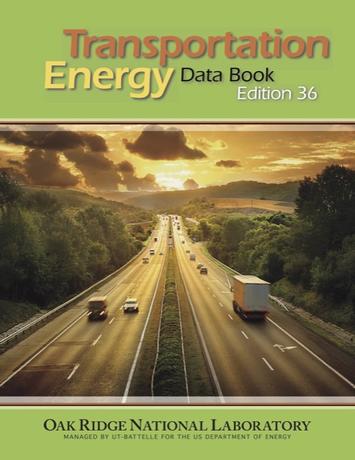
The average car on the road consumed 4,700 British thermal units (BTUs) per vehicle mile in 2015, which is almost a 50 percent reduction from 1973, when Americans drove some of the gas-guzzliest cars in history. The average light truck (meaning pick ups, full-sized vans, and SUVs) used about 6,250 BTUs per vehicle mile in 2015, which is also about half what it was in the early 1970s.
Click here to download a 10.2-MB PDF of the report. Use links below to download spreadsheets or individual chapters from the report.
By comparison, the average transit bus used 15 percent more BTUs per vehicle mile in 2015 than transit buses did in 1970. Since bus occupancies have declined, BTUs per passenger mile have risen by 63 percent since 1970. While buses once used only about half as much energy per passenger mile as cars, they now use about a third more.
These numbers are from table 2.15 in the latest Transportation Energy Data Book, which has energy consumption data for various forms of transportation through 2015. Table 2.16 reveals that the energy consumed by airlines per passenger mile has declined by more than 75 percent since 1970, so now it is more energy efficient to fly than to drive (at least, if your car is carrying the average 1.55 occupants).
The same table reports that rail transit uses slightly more energy per passenger mile today than it did in 1970. However, the rail numbers in the table must be read with caution: a footnote warns that “Only end-use energy was counted for electricity. Previous editions included primary energy use for electricity which included generation and distribution losses.” Generation and distribution losses are about 67 percent of electrical energy, so the BTUs in the table must be tripled to get the actual amount of energy consumed to move people by electric transit.
The numbers are also a problem for Amtrak, as about a third of Amtrak passenger miles are carried on electric-powered (as opposed to Diesel-electric) trains. The previous edition of the data book indicated that Amtrak used 2,186 BTUs per passenger mile in 2014, while the latest edition “corrects” this to 1,641. In other words, Amtrak really requires about a third more energy than is shown in the data book. That still makes it slightly more efficient than flying, but not much. I suspect that, if the numbers were broken down by route, a few heavily used routes would be energy-efficient while most of the rest would not.
The authors of the data book offer no explanation for why they changed from counting electrical energy from total to end-use. It would be like saying that the average gasoline engine is only about 35 percent efficient, as the other 65 percent is lost as heat, so therefore we’re only going to count the 35 percent of gasoline used to actually move the vehicles. This is a bewildering and disappointing change as it greatly understates energy consumption required for electric-powered transportation.
Update: In an email, one of the book’s authors explained that they decided it wasn’t appropriate to count the “upstream” costs of electrical energy if they didn’t also count the energy costs of locating and extracting fossil fuels. In other words, the data book is not an attempt at doing a life-cycle analysis. My response is that the electrical grid is a closed system and all the costs within that system need to be counted just as they would be if the vehicles themselves were generating the electricity (such as in a hybrid car).
Another problem with the data book is that table 2.16 combines light and heavy rail in the rail transit numbers, which is sort of like combining minivans with full-sized buses. Fortunately, this edition has supplemental figures 2.07 and 2.08 showing BTUs per passenger mile of individual light- and heavy-rail lines. Remember to triple all of the numbers to get actual energy consumed.
One other important piece of information is missing from the data book. The tables show BTUs per vehicle mile for cars, light trucks, and transit buses, and BTUs per passenger mile for cars, transit, planes, and Amtrak. But no table shows BTUs per passenger mile for light trucks.
To convert vehicle miles to passenger miles, the book’s authors used average passenger car occupancies of 1.55 people per car, which is from the 2009 National Household Travel Survey. Average light truck occupancies are higher, so to convert BTUs per vehicle mile to BTUs per passenger mile, divide the former by 1.72. The result is about 3,600 BTUs, which is 20 percent more than cars but still 10 percent less than transit buses.
This piece first appeared on The Antiplanner.
Randal O’Toole is a senior fellow with the Cato Institute specializing in land use and transportation policy. He has written several books demonstrating the futility of government planning. Prior to working for Cato, he taught environmental economics at Yale, UC Berkeley, and Utah State University.












